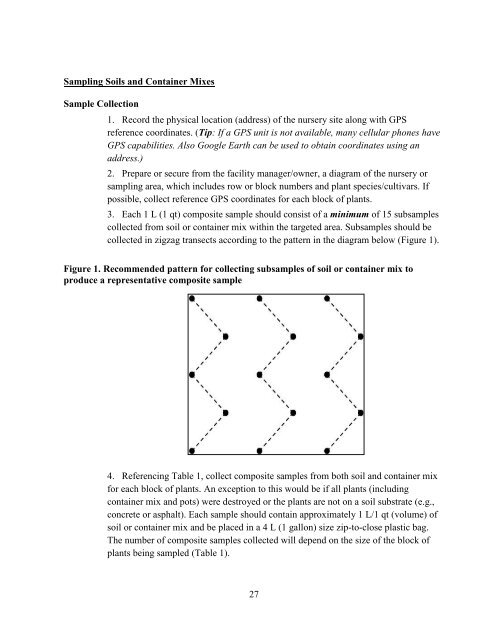Confirmed Nursery Protocol - aphis
Confirmed Nursery Protocol - aphis
Confirmed Nursery Protocol - aphis
Create successful ePaper yourself
Turn your PDF publications into a flip-book with our unique Google optimized e-Paper software.
Sampling Soils and Container Mixes<br />
Sample Collection<br />
1. Record the physical location (address) of the nursery site along with GPS<br />
reference coordinates. (Tip: If a GPS unit is not available, many cellular phones have<br />
GPS capabilities. Also Google Earth can be used to obtain coordinates using an<br />
address.)<br />
2. Prepare or secure from the facility manager/owner, a diagram of the nursery or<br />
sampling area, which includes row or block numbers and plant species/cultivars. If<br />
possible, collect reference GPS coordinates for each block of plants.<br />
3. Each 1 L (1 qt) composite sample should consist of a minimum of 15 subsamples<br />
collected from soil or container mix within the targeted area. Subsamples should be<br />
collected in zigzag transects according to the pattern in the diagram below (Figure 1).<br />
Figure 1. Recommended pattern for collecting subsamples of soil or container mix to<br />
produce a representative composite sample<br />
4. Referencing Table 1, collect composite samples from both soil and container mix<br />
for each block of plants. An exception to this would be if all plants (including<br />
container mix and pots) were destroyed or the plants are not on a soil substrate (e.g.,<br />
concrete or asphalt). Each sample should contain approximately 1 L/1 qt (volume) of<br />
soil or container mix and be placed in a 4 L (1 gallon) size zip-to-close plastic bag.<br />
The number of composite samples collected will depend on the size of the block of<br />
plants being sampled (Table 1).<br />
27
















